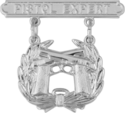John Marston (USMC)
John Marston VI | |
|---|---|
| Battles/wars | Veracruz Expedition World War I Haitian Campaign Nicaraguan Campaign
|
| Relations | RADM John Marston III (great-grandfather) LTCOL John Marston VII (son) |
John Marston VI (August 3, 1884 – November 25, 1957) was a
Early life and family
John Marston VI was born on August 3, 1884, in Somerset County, Pennsylvania, to a family with a long military tradition. His great-great-great-grandfather John Marston I (1715–1786) was a captain with the 3rd Massachusetts Bay Artillery and participated in the Siege of Louisburg in the War of the Austrian Succession. Marston's great-great-grandfather John Marston II (1756–1846) served as a major in the Massachusetts Militia during the American Revolutionary War, and his great-grandfather was John Marston III, who commanded the steam frigate USS "Roanoke during the Battle of Hampton Roads in the American Civil War and was eventually promoted to rear admiral after the war.
Only Marston's father, John Marston V, did not serve in the military. He worked as a chief engineer in Williamsport and North Branch Railroad Company. Marston VI attended the University of Pennsylvania, as his father had, and graduated in June 1904 or "in the class of 1905".[1] However, Marston chose to serve his country as his ancestors had, and entered the Marine Corps on June 4, 1908. Because of his university education, he was appointed a second lieutenant on the same date.
After his appointment to the Marine Corps, Marston attended Marine School of Application in Washington, D.C. After graduating in January 1909, he sailed for shore duty to Hawaii, where he served at the Marine barracks in Honolulu until October. He was subsequently transferred to Portsmouth Naval Prison, Maine, where he served within the Marine barracks until May 1912. During his time there, he was promoted to the rank of first lieutenant in March 1911.
Marston was subsequently assigned to the Marine detachment aboard the battleship USS Michigan (BB-27) and remained there until he was transferred to the Marine barracks at Philadelphia Navy Yard. While stationed there, he was assigned to the Advanced Base Force within the 1st Brigade of Marines and sailed for Veracruz, Mexico in April 1914.[2] He subsequently served with occupation forces until the summer of 1915.
During August 1915, then-Lieutenant Marston was sent to
Interwar period
After his return to the United States, he was appointed commanding officer of Marine detachment within the Naval Academy at Annapolis, Maryland. Following two years of service there, Marston was promoted to the rank of major on July 22, 1920, and transferred to the Marine Barracks Quantico, Virginia. From 1922 to 1924, he was assigned to the American legation in Managua, Nicaragua.[2] Other postings followed, including a brief return to Nicaragua. Then he was assigned to the American embassy in Peiping, where he was the commander of the Marine detachment from 1937 to 1938 and the senior commander of Marine forces in North China from 1938 to 1939.[2][3]
World War II

With the increasing threat of German occupation of
The 2nd Division was ordered to the
After his arrival, he was diagnosed with
Marston served in this capacity until April 20, 1944, when he was appointed commanding general of Camp Lejeune, North Carolina.[2] He remained in this position for the rest of the war and finally retired from the Marine Corps in 1946.[2]
After his retirement, Marston lived in Lexington, Virginia, and died on November 25, 1957. He is buried at local Oak Grove Cemetery together with his wife, Elizabeth Worthington Marston (1889–1961). They had one son, John Marston VII (1917–1978), who also served in the Marine Corps and was decorated with the Silver Star while serving with the 6th Marine Division on Okinawa. Marston VII retired as a lieutenant colonel.
Military awards
The following are Major General Marston's decorations and awards. It is not clear whether Marston received any decorations for merit during World War II.
| | |||

|

| ||
| 1st Row | Marine Corps Expeditionary Medal with two 3⁄16" bronze stars | Mexican Service Medal | ||||||||||
|---|---|---|---|---|---|---|---|---|---|---|---|---|
| 2nd Row | Haitian Campaign Medal | World War I Victory Medal with West Indies clasp | Second Nicaraguan Campaign Medal | China Service Medal | ||||||||
| 3rd Row | American Defense Service Medal with "A" Device | American Campaign Medal | European–African–Middle Eastern Campaign Medal | Asiatic-Pacific Campaign Medal with one 3⁄16" bronze star
| ||||||||
| 4th Row | World War II Victory Medal
|
Nicaraguan Presidential Medal of Merit with Diploma | Nicaraguan Cross of Valor | Nicaraguan Medal for Merit | ||||||||
Military offices
References
- ^ a b c "Maj. Gen. Marston New Department of Pacific Commander". Marine Corps Chevron. 2 (35). 4 September 1943.
- ^ a b c d e f g "Major General John Marston". National Park Service.
- ^ "The China Marines: Personalities". chinamarine.org.
- ^ a b c d e f Lieutenant Colonel Kenneth J. Clifford, USMCR, ed. (1970). "The United States Marines in Iceland, 1941–1942" (PDF). United States Marine Corps.
- ^ ISBN 9780252068911.
